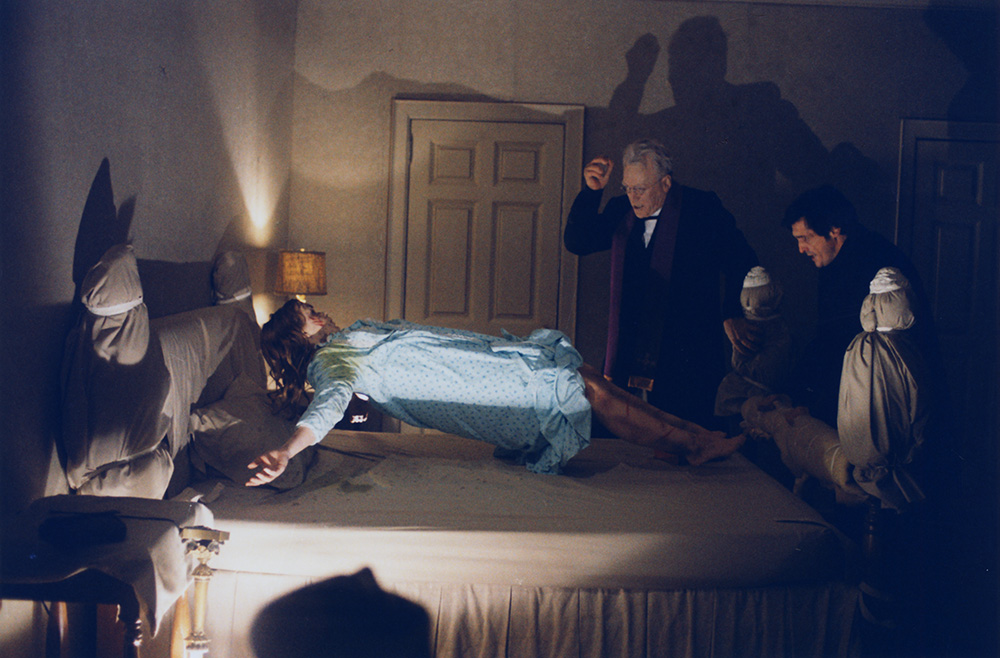2013 marks not just 40 years of Roe v. Wade–and 10 years of The Revealer!–but 40 years of The Exorcist, the classic horror movie about piety and possession in a little girl’s upstairs bedroom. Besides tackling our all-time favorite subjects (the Catholic Church and your body!) The Exorcist has one of our favorite creepy actors, Max von Sydow (think Virgin Spring when von Sydow tosses a vagabond boy across the room to his death!).
Some anniversaries are for celebrating how much things have stayed the same; you’re still married, still an employee somewhere, still alive. Others are for examining how much things have changed. I don’t know which kind this is, as we think about the role of the Catholic Church in our lives–literally in our lives (and bodies) when it comes to health care. But the increment of 40 comes up a lot when you talk about medicine, culture and religion. Maybe media phenomenons like The Exorcist can help explain why?
Here’s a clip from W. Scott Poole’s 2010 book, Satan in America: The Devil We Know:
In major cities, long lines snaked around entire city blocks as moviegoers waited for an opportunity to see a film that had become a cultural sensation. Enormous crowds forced the management of Cinema One in midtown Manhattan to turn away fans that had waited four hours to get in to an opening show, starting a small riot. In the Chicago suburbs, complaints of noise and property damage heralded the film’s opening. In Beverly Hills, one theatre began showing the film at 8:00 AM to meet the enormous demand and still had to turn away thousands of people.
The Exorcist is based on a novel by William Peter Blatty. Blatty’s interest in demon possession was influenced by his own complicated relationship to Catholicism and inspired by a 1949 exorcism that had taken place in Mt. Rainer, Maryland, during Blatty’s student days at Georgetown University. The novel and the film tell the story of an adolescent girl named Regan (echoing the rebellious daughter of Lear in Shakespeare’s tragedy) possessed by the ancient demonic spirit called Pazuzu. Her mother is forced to turn to two priests, Father Karras and Father Merrin, as her daughter’s upstairs bedroom becomes a carnival of horrors. The bed floats, sacrileges abound, and blood and green vomit splatter as the camera pulls audiences into the small, claustrophobic room with the demonic child and embattled priests. The nuanced ending leaves many feeling that evil has triumphed.
Audience reactions at the time represented a phenomenon in and of themselves. Only days after the film’s nationwide release, reports began to filter in of a bizarre physical and psychological reaction that American audiences were having in response to the disturbing images on the screen. Although some of these reports, especially those hyped by theatre managers, can be attributed to efforts at free publicity, hundreds of people did have reactions that ranged from vomiting, to weeks of nightmares to, in a slim number of cases, psychological breakdowns.
The Exorcist, both in the story it told and the cultural impact it made, had implications that stretched far beyond its power to overwhelm audiences. The film drew on images of demonic evil that went back to the American founding and stretched back through the Middle Ages. It inaugurated a moment in American cultural life when the devil occupied a place in public discourse not held at any time or place in America since the New England settlements of the seventeenth century. While Satan had always been a primary site for the construction of American notions of innocence and of evil, by the 1980s the demonic had become a central cultural discourse, a social mechanism that worked on multiple levels of American religion and popular entertainment.


